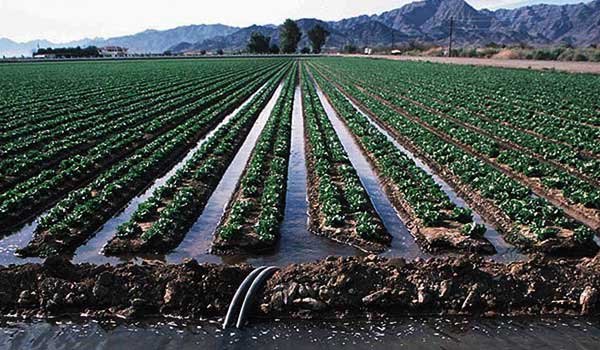
There are various types of irrigation systems. For irrigation purposes both surface water and ground water are utilized. Irrigation system can be classified as:
- Gravity Irrigation
- Pumped Irrigation
- Tidal Irrigation
Gravity Irrigation
In gravity type of irrigation, water is conveyed to the field by gravity only. Such an irrigation system consists of head works across the river and water distribution system i.e. Canal network. The canals supply regular water in accordance with availability of water and requirement of crops. It can further be classified as i) Run-of-the river scheme & ii) Storage scheme
Run-of-the River Scheme
In this system a weir or a barrage is constructed across the river to raise its water level to such an extent that the flow is diverted in the canal system. It may be stated that in a run-of-the river scheme, the daily discharge of the river is diverted into the canal system; and the maximum discharge is limited by the head capacity of the canal. If the discharge in the river is more than the canal capacity, the excess is allowed to flow down the river, Ganga Canal System and Sharda Canal System in Uttar Pradesh are the examples of this scheme.
Storage scheme
In the storage system, a dam is constructed to store water in monsoon so as to serve as source of water supply in canals during irrigation and power demand e.g. Ramganga scheme in UK/UP and Bhakra Dam scheme in H.P/Punjab.
In storage scheme, since the river discharge is stored in the reservoir and is released according to the irrigation demand, it is obvious that in this case more optimum utilization of water resources are possible than in run-of-the river schemes. Storage schemes are however, costlier and are justified when multiple use of stored water can be made.
Pumped Irrigation
In this type of irrigation system, water is lifted by pumps and may be classified as i) Pumped Irrigation from surface water and ii) Pumped irrigation from ground water. Pumped irrigation scheme from surface water is usually termed as lift irrigation while the latter is called Tube-well Irrigation.
Lift Irrigation
It is a scheme taking water from relatively big rivers. The scheme is adopted where construction of a weir or a barrage is considered impractical due to high cost. Lift irrigation may also be provided in part of gravity canal system to serve areas located in higher levels.
A novel method of design of pump house has been evolved in UP. In this method, pumps are installed on big floating barges. The supply of water is thus ensured during all stages of the rivers as the location and level of the barges are adjustable.
Tube-well Irrigation
Primitive methods of lifting water from wells for irrigation are still in vogue in the villages. These are now being gradually replaced by pumps and tube-wells.
Tube-well is the most economical method of utilizing ground water resources. As the name indicates a small hole deep in the ground is drilled and water is drawn by pump installed at the ground surface.
Tidal Irrigation
In a tidal type of irrigation scheme, the irrigated area is inundated during monsoon when the river flows are high. In this system there is no control over the amount of river flow. The moisture stored in the soil due to inundation, supplemented by natural rainfall or minor waterings, bring the crops to maturity. It is also termed as flood irrigation.
Other methods of irrigation
There are certain other methods of irrigation practiced in certain specific localities. In rolling country bunds or tanks are constructed to collect rain water. The water from these bunds is released for irrigation during non-monsoon period. In deltaic region delta irrigation is practiced. In this system water is diverted to land during floods by constructing temporary headworks.
